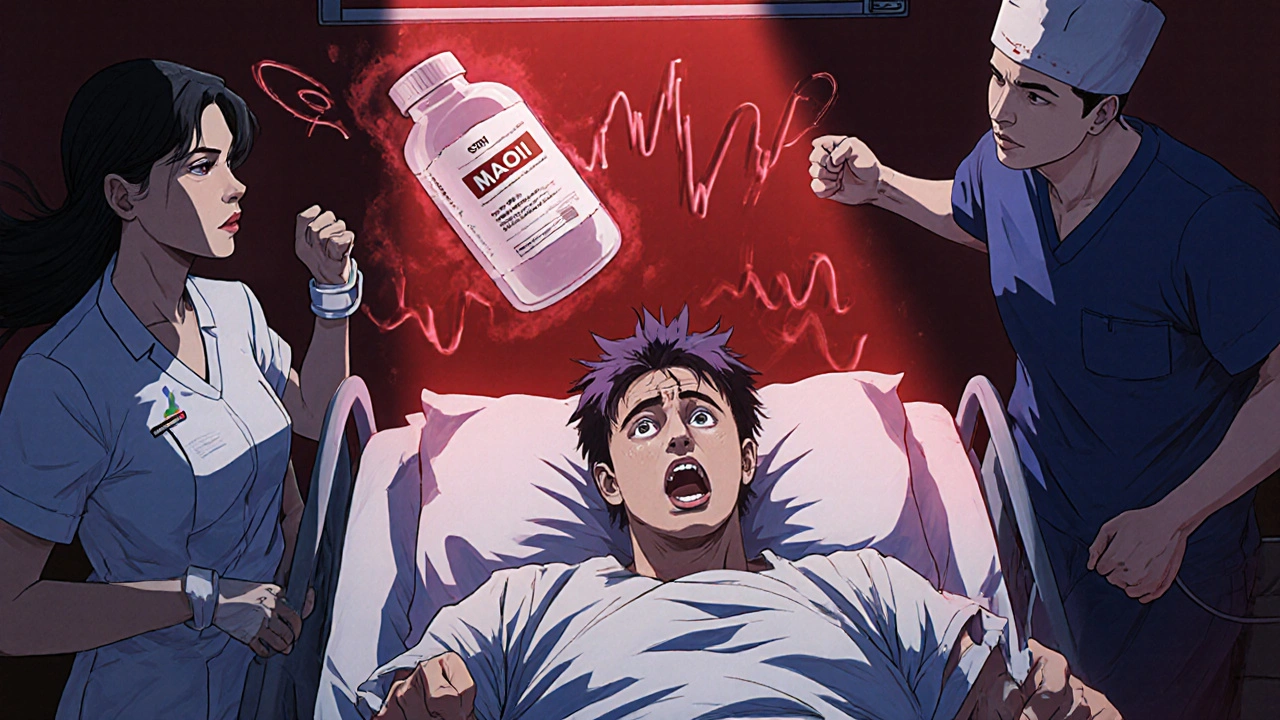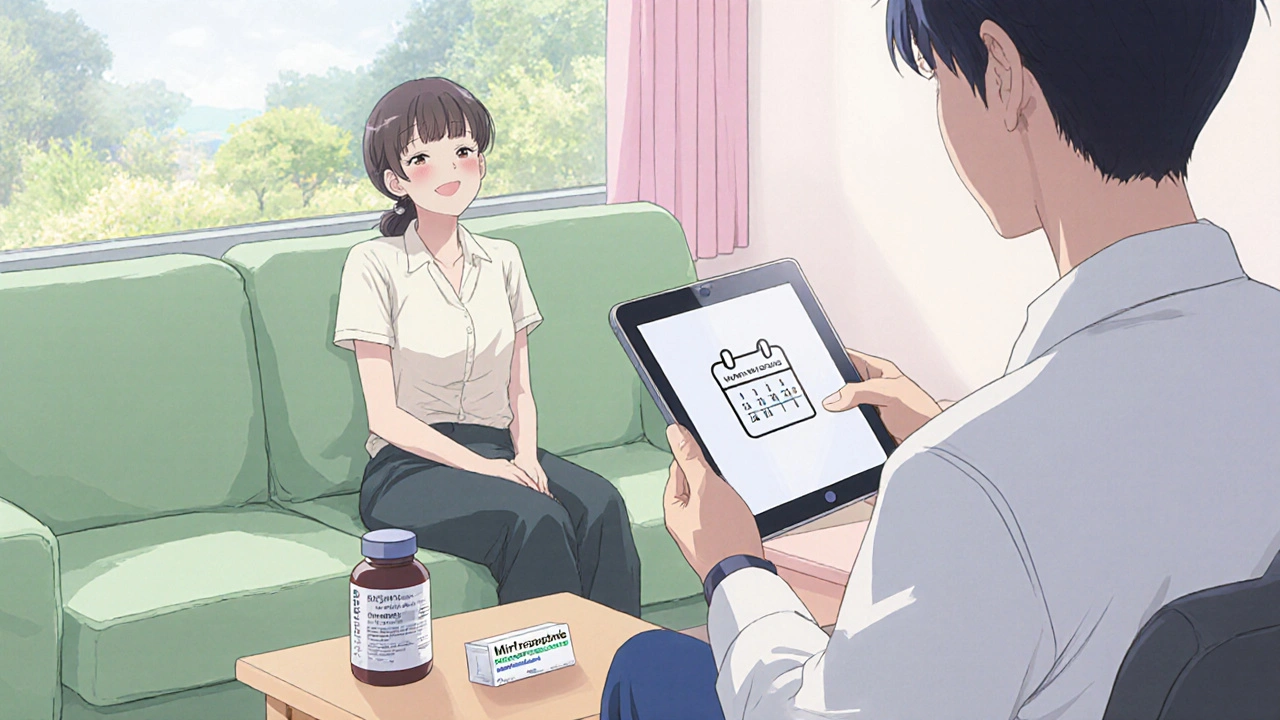MAOI Drug Interaction Checker
MAOI Drug Combination Checker
Results
Select medications to check interaction
Key Safety Information
Serotonin Syndrome
A life-threatening condition characterized by high fever, muscle rigidity, rapid heart rate, agitation, and confusion. May occur when combining MAOIs with drugs that increase serotonin levels.
Never combine an MAOI with: SSRIs, SNRIs, or highly serotonergic TCAs like clomipramine. These combinations carry a high risk of serotonin syndrome.
Washout Periods: For fluoxetine, a 5-week washout is required after stopping before starting an MAOI. For most other SSRIs, SNRIs, and TCAs, 2 weeks is sufficient. When switching from MAOI to another antidepressant, wait at least 2 weeks.
Always monitor vitals, blood pressure, and signs of serotonin syndrome when combining medications.
When treatment‑resistant depression forces clinicians to look beyond first‑line pills, Monoamine oxidase inhibitors (MAOIs) are a class of antidepressants that block the monoamine oxidase enzyme, raising levels of serotonin, norepinephrine and dopamine in the brain. Their power comes with a reputation for tricky drug and food interactions, especially when mixed with other antidepressants. This guide breaks down the most dangerous pairings, explains why serotonin syndrome spikes, and points out the safest drugs you can combine with an MAOI.
What makes MAOIs unique?
MAOIs were the first antidepressants on the market in the late 1950s. By inhibiting the two isoforms of monoamine oxidase (MAO‑A and MAO‑B), they prevent the breakdown of key mood‑regulating neurotransmitters. The result is a broad boost in serotonin, norepinephrine and dopamine - a pharmacological profile that still outperforms many newer agents in atypical and severe treatment‑resistant depression (TRD).
Four oral agents dominate the market today: phenelzine (Nardil), tranylcypromine (Parnate), isocarboxazid (Marplan) and the transdermal selegiline patch (Emsam). The patch, approved in 2006, delivers lower systemic doses and sidesteps most dietary restrictions, but the core enzyme‑blocking action remains the same.
Why mixing antidepressants can be dangerous
The biggest safety alarm is serotonin syndrome - a rapid, life‑threatening surge of serotonin activity. Symptoms include high fever, muscle rigidity, rapid heart rate, agitation and confusion. When an MAOI is added to a drug that already blocks serotonin reuptake, the body loses its primary way to clear excess serotonin, setting the stage for a toxic cascade.
Regulatory agencies label this combination a contraindication, and FDA boxed warnings forbid pairing MAOIs with selective serotonin reuptake inhibitors (SSRIs), serotonin‑norepinephrine reuptake inhibitors (SNRIs) and several tricyclic antidepressants (TCAs). The risk isn’t theoretical; a 1995 case series reported seven deaths out of eight patients who received fluoxetine together with tranylcypromine.
High‑risk pairings you should avoid
SSRIs and SNRIs - Fluoxetine, sertraline, escitalopram, venlafaxine and duloxetine all carry long half‑lives. Fluoxetine’s active metabolite can linger for weeks, so the FDA recommends a five‑week washout before starting an MAOI. Other SSRIs need at least a 14‑day gap.
TCAs with strong serotonergic activity - Clomipramine is a clear no‑go because it blocks serotonin reuptake very potently. Even standard TCAs like amitriptyline can raise serotonin levels enough to trigger syndrome if the MAOI is introduced first.
When an MAOI is the first drug, the monoamine oxidase enzyme stays blocked for several days after stopping the MAOI. Starting an SSRI or SNRI during that window dramatically raises syndrome risk.

Is every MAOI‑TCA combo unsafe?
Recent studies have softened the blanket prohibition. A 2022 review of peer‑reviewed trials found that when the TCA is introduced **before** or **simultaneously with** the MAOI, many patients tolerate the mix without serotonin toxicity. One landmark trial (Amsterdam & Bodkin, 2009) reported a 57 % response rate in 56 TRD patients given phenelzine plus nortriptyline, with only mild side‑effects.
Key takeaways from the evidence:
- Never add an MAOI to a patient already on a serotonergic TCA.
- Start the TCA first, allow steady‑state plasma levels, then add the MAOI at a low dose.
- Monitor blood pressure, heart rate and mental status closely for the first two weeks.
Clinicians still need to weigh the modest benefit against the monitoring burden, especially when safer alternatives exist.
Safer antidepressants you can pair with an MAOI
Several non‑serotonergic agents have been used successfully alongside MAOIs, offering mood lift without the serotonin‑overload danger.
| Drug | Class | Key Benefit | Typical Dose with MAOI |
|---|---|---|---|
| Bupropion | Norepinephrine‑dopamine reuptake inhibitor | Improves energy, reduces sexual side‑effects | 150 mg daily, added after 2‑week MAOI washout |
| Mirtazapine | Noradrenergic and specific serotonergic antagonist | Helps with insomnia and appetite | 15 mg at bedtime, start low, go slow |
| Trazodone | Sedating serotonin antagonist | Sleep aid with modest antidepressant effect | 50 mg nightly, titrate over 2 weeks |
| Nortriptyline | Tricyclic, weak serotonin reuptake | Balanced efficacy, lower serotonergic load | 25 mg nightly, introduced before MAOI |
These agents lack strong serotonin‑reuptake inhibition, so the enzyme‑blocking action of the MAOI doesn’t push serotonin into toxic territory. The “start low, go slow” principle still applies: change only one drug at a time, give at least a week between dose adjustments, and keep blood pressure cuffs handy.
Practical steps: washout periods, titration and monitoring
Washout periods - The rule of thumb is 5 weeks after stopping fluoxetine, because its metabolite norfluoxetine clings around. For all other SSRIs, SNRIs and most TCAs, a 2‑week gap is sufficient. When switching **from** an MAOI **to** another antidepressant, wait at least 2 weeks for the enzyme to recover.
Titration - Begin the MAOI at the lowest available dose (e.g., phenelzine 15 mg/day). Increase by 15 mg increments every 3‑5 days while watching for hypertensive spikes or orthostatic changes. Add the partner drug at its starting dose, then titrate in weekly steps.
Monitoring checklist
- Vitals every 4 hours for the first 48 hours after a new combination.
- Signs of serotonin syndrome: agitation, hyperreflexia, clonus, fever >38 °C.
- Blood pressure trends, especially after tyramine‑rich meals.
- Patient self‑report of nausea, dizziness, sleep changes.
If any severe symptom appears, stop the newest drug immediately and seek emergency care.

Dietary considerations - tyramine still matters
Even with the transdermal selegiline patch, higher doses (>10 mg/24 h) can react with tyramine. Until the MAOI is stopped, patients should avoid aged cheeses (>20 mg tyramine/100 g), tap beers (>10 mg/100 ml) and fermented sausages (>100 mg/100 g). The restriction usually lifts two weeks after the last MAOI dose.
Because dietary vigilance can feel burdensome, many clinicians reserve MAOIs for patients who have already tried and failed at least two other antidepressant classes.
Choosing the right MAOI and partner drug
If a patient’s main complaint is hypersomnia and heavy‑leg feeling, phenelzine plus mirtazapine often works well. For predominant anhedonia, a low‑dose selegiline patch paired with bupropion can boost dopamine without shaking serotonin levels. Patients with high blood‑pressure sensitivity may prefer isocarboxazid at a modest dose and avoid tyramine‑rich foods altogether.
Never forget the patient’s overall medication load. Adding a benzodiazepine for anxiety or a non‑benzodiazepine sleep aid (e.g., zolpidem) usually poses no extra serotonin risk, but it does increase fall risk in older adults.
Key takeaways
- MAOIs are powerful for TRD but demand strict washout periods when combined with serotonergic drugs.
- The biggest red flag is mixing an MAOI with any SSRI, SNRI or a strongly serotonergic TCA - it can trigger MAOI drug interactions that lead to serotonin syndrome.
- Evidence shows that certain TCA‑MAOI combos can be safe if the TCA starts first and dosing is gradual.
- Safer partners include bupropion, mirtazapine, trazodone and nortriptyline - they avoid major serotonin spikes.
- Always monitor vitals, watch for serotonin syndrome signs, and keep dietary tyramine restrictions in place until two weeks after stopping the MAOI.
Can I take fluoxetine and phenelzine together if I miss a dose?
No. Even a single missed dose can leave enough fluoxetine in the system to cause serotonin syndrome when phenelzine is added. The safe practice is a full five‑week washout after the last fluoxetine dose before starting any MAOI.
Is the selegiline patch completely free of dietary restrictions?
At the low 6 mg/24 h dose, most patients can eat normally. Higher doses (>10 mg/24 h) still require tyramine avoidance because enough systemic MAO‑B inhibition occurs to trigger hypertensive spikes.
What signs should I watch for that indicate serotonin syndrome?
Look for rapid heart rate, high fever, sweaty skin, muscle rigidity, hyperreflexia, clonus, agitation, and confusion. If any appear after starting a new drug combination, seek emergency care immediately.
Can bupropion be used with any MAOI?
Bupropion is generally safe because it doesn’t increase serotonin. Still, give a two‑week washout after stopping the MAOI and start bupropion at a low dose, monitoring blood pressure.
What is the recommended taper schedule for stopping phenelzine?
Reduce the dose by 25 % every 3‑5 days until you reach 15 mg every other day, then stop. Keep monitoring for withdrawal symptoms like restlessness, flu‑like aches, and sleep disruption for 2‑4 weeks.







Edward Brown
October 25, 2025 AT 17:23They say MAOIs are a relic of a bygone era but what if the pharma giants are deliberately keeping us in the dark about safer combos the truth being hidden behind a veil of regulatory red tape each warning box a shield for hidden profit the patient ends up fearing tyramine when the real danger might be undisclosed drug interactions the system rewards secrecy not safety.
ALBERT HENDERSHOT JR.
October 26, 2025 AT 10:13Great summary-makes the complex world of MAOI interactions much clearer 😊.
Suzanne Carawan
October 27, 2025 AT 04:16Oh sure, just ignore the whole 5‑week washout and wing it, why not? The risk of serotonin syndrome is just a myth invented by bored clinicians. Enjoy your fireworks.
Kala Rani
October 27, 2025 AT 22:20Food restrictions are overrated they make life harder than the meds themselves.
Donal Hinely
October 28, 2025 AT 16:23Listen up, the world of MAOIs isn’t some boring textbook chapter it’s a battlefield where only the bold survive and if you’re not willing to sidestep tyramine‑laden cheeses and tap beers you might as well stay in the safe zone of SSRIs – but then you’ll never know the real power of a well‑timed phenelzine boost.
christine badilla
October 29, 2025 AT 10:26Wow, reading this feels like watching a drama unfold in a hospital corridor – the tension of titrating doses, the heartbreak of missed washout periods, and the ultimate crescendo when a patient finally finds relief after weeks of sleepless nights, it’s raw, it’s real, and it deserves a standing ovation.
Octavia Clahar
October 30, 2025 AT 04:30Honestly, if you’re still debating whether to pair bupropion with an MAOI, you might as well be arguing over which flavor of ice cream is superior – the answer is obvious, stick to the low‑serotonin combos and stop wasting time.
eko lennon
October 30, 2025 AT 22:33When I first stumbled onto the idea of using an MAOI for my treatment‑resistant depression, I was terrified of the infamous tyramine blacklist. I spent days scrolling through forums, reading FDA warnings, and consulting my psychiatrist about the dreaded five‑week washout. The doctor explained that phenelzine blocks both MAO‑A and MAO‑B, which means that even a tiny sip of aged cheese could theoretically spike blood pressure. Yet he also mentioned that the transdermal selegiline patch at low doses sidesteps many of those dietary pitfalls. I decided to start with a low‑dose phenelzine, 15 mg daily, and kept a meticulous diary of everything I ate. Every morning I logged my coffee, my toast, and whether I felt any jittery sensations. After two weeks, my mood began to lift, but I also noticed a subtle tremor in my hands that I hadn't experienced before. I called my doctor, who reminded me that early side effects are common and that close monitoring is essential. We added a gentle titration plan for mirtazapine, starting at 15 mg at bedtime to help with my insomnia. The combination was introduced slowly, with a week between dose adjustments, adhering to the principle of "start low, go slow." Within a month, my depressive symptoms had receded enough that I could engage in daily activities without the crushing weight that had dominated my life. Importantly, I never experienced the hallmark signs of serotonin syndrome – no fever, no severe muscle rigidity, and my reflexes remained normal. Our regular vitals checks every four hours for the first 48 hours after each change showed stable blood pressure and heart rate. The experience taught me that with disciplined monitoring, the feared interactions can be managed safely. Now, looking back, I appreciate how the careful protocol turned a daunting pharmacological mountain into a manageable climb.
Sunita Basnet
October 31, 2025 AT 16:36Leverage synergistic pharmacodynamics by aligning dopaminergic augmentation via bupropion with MAOI-mediated monoamine elevation – this combinatorial strategy optimizes neurotransmitter homeostasis while minimizing serotonergic overload, boosting therapeutic outcomes.
Melody Barton
November 1, 2025 AT 10:40Stick to the basics: start low, watch vitals, keep tyramine away, and you’ll navigate MAOI combos without blowing up.
Justin Scherer
November 2, 2025 AT 04:43I find it helpful to keep a clear checklist when switching to or from an MAOI – note the last dose date, confirm the washout period, schedule vitals monitoring, and document any adverse signs promptly.
Pamela Clark
November 2, 2025 AT 22:46Oh, a checklist? How groundbreaking – next you’ll tell us the sky is blue.
Diane Holding
November 3, 2025 AT 16:50Always double‑check the washout window before adding any serotonergic agent.
Cheyanne Moxley
November 4, 2025 AT 10:53Seriously, if you ignore that simple rule you’re basically inviting a serotonin firestorm – it’s not rocket science, it’s basic patient safety.
Kevin Stratton
November 5, 2025 AT 04:56In the grand tapestry of neurochemistry, each drug is a thread; pull the wrong one and the whole pattern unravels 🧵.